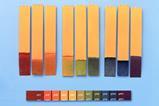Support learners to retrieve information on structure and bonding in different forms of carbon
This resource is part of our support for literacy in science teaching, designed to embed literacy into your curriculum and develop learners’ skills in reading, writing and talking about science and their understanding of scientific language.
-

Download this
Download the structure strips, which are printed five to a page, to support learners to find or retrieve information and write independently.
Find model answers in the teacher guidance.
View and download more Structure strips
Learning objectives
- Describe the bonding in different allotropes of carbon.
- Explain how the structure and bonding of allotropes of carbon leads to their different properties.
Introduction
Carbon is one of the most versatile elements in the periodic table. It is one of the ‘elements of life’ present in all living things. Carbon is so special that it has a whole branch of chemistry dedicated to it, this is called organic chemistry.
In this activity, you will look at the structure and bonding of carbon as an element where it forms different macromolecular structures. Different structural forms of the same element are called allotropes.
How to use structure strips
Structure strips are a type of scaffolding you can use to support learners to retrieve information independently. Use them to take an overview at the start of the topic, to activate prior knowledge, or to summarise learning at the end of a teaching topic. For more ideas on how to use structure strips with your learners, see 5 ways to use structure strips effectively
Structure strips have sections containing prompts which are sized to suggest the amount that learners must write. Learners glue the strips into the margin of an exercise book and write their answers next to the sections, in full sentences. When learners have finished using the structure strip, they should have an A4 page set of notes and examples.
The strips are printed five to a page and will need to be trimmed to size. Find them on the second page of the student sheet.
Scaffolding
Additional scaffolding may be required to support learners to answer the questions. You could include a list of key words or add further prompts to the structure strip.
As learners grow in confidence they may be able to answer the question without the structure strip or attempt the question first and then use the structure strip to self-assess and improve their answer.
Metacognition
This activity supports learners to develop their metacognitive skills in the three key areas:
- Planning: the strips provide scaffolding to plan the written response. Learners will decide where to gather information from (eg textbooks, own notes, revision websites). Ask learners: is the source of information I am using reliable?
- Monitoring: learners are prompted by the questions in the structure strip and can check their answer against the prompts. Ask learners: have you covered all of the questions in the space provided? Do you need to change anything to complete the task?
- Evaluation: learners can self-assess or ask a peer to check their work against the answers. Ask learners: did you achieve what you meant to achieve? What might you do differently next time?
Keywords
Allotrope, atom, bond, conductivity, covalent, delocalised, diamond, electron configuration, fullerene, graphene, graphite, intermolecular, lattice, macromolecule, molecule, subatomic particle.
Follow-up question
Learners answer this question after attempting the structure strip. The structure strip activates the required knowledge which learners can then apply to this question.
Diamond drill bits are used in lots of applications including drilling porcelain, stone and concrete.
(a) State which property of diamond makes it useful for this purpose.
(b) Explain how the structure and bonding in diamond leads to this property.
Answers
Suggested answers for the structure strip activity are in the downloadable teacher notes.
Answers to follow-up question
(a) Hardness
(b) Diamond is a giant structure/lattice/macromolecule. It has four strong covalent bonds per atom.
The answer given here is a very succinct response written with keywords. It is unlikely learners will write such a short, to the point, response on their first attempt but this can be used as a good learning opportunity. Encourage learners to use fewer, better words in subsequent attempts.
Downloads
Allotropes of carbon structure strip student sheet
Handout | PDF, Size 0.13 mbAllotropes of carbon structure strip teacher notes and answers
Handout | PDF, Size 0.15 mbAllotropes of carbon structure strip student sheet
Editable handout | Word, Size 0.43 mbAllotropes of carbon structure strip teacher notes and answers
Editable handout | Word, Size 0.43 mb








































No comments yet